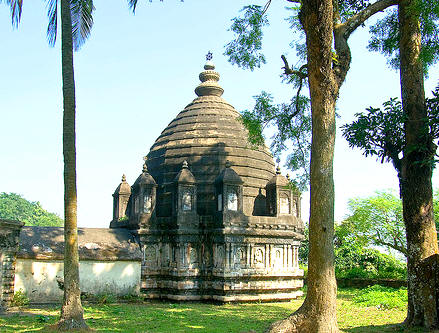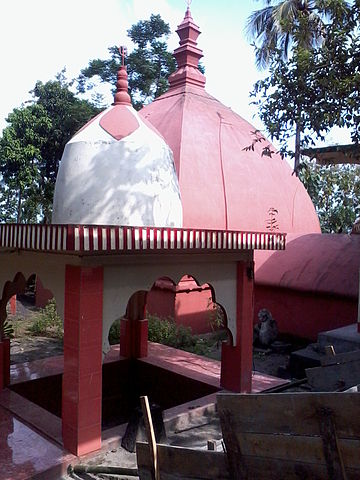In and Around North Guwahati
Aswakranta & Aswaklanta Temple

Aswaklanta is one of ancient temple in Assam famous as Hindu pilgrimage. Situated near to Guwahati and Brahmaputra, this temple also carries scenic beauty.
Aswaklanta Temple was built by Ahom King Shiva Singha in 1720. Shiva Singha built most of the biggest Hindu temples of Assam including the famous Shiva Dole of Sivasagar. The temple is situated by the bank of mighty Brahmaputra. There are two temples in that holy place. One situated in the foot hill and the other in the up hill - Kurmayanardan and Anantasayi by name.
The place where the temples were built holds Hindu mythological importance. Mythology says that while Lord Krishna searched for Narakasur to kill him, his horse got tired in this place.This is how this place was named Aswa-Klanta. Aswa means 'Horse' and Klanta means 'Tired' in Assamese. According to another legend, horses belonged to Arjun, the great Pandava and friend of Krishna, were persuaded in this place to stay back from the better scene so that Abhimanyu could get killed. It was a conspiracy and called 'abhikranta' in assamese. From this word the place was named as Aswa-krata. And later it became Aswaklanta in popular language.
Rudreswar Devalaya

The Rudreswar Temple or Devaloya is a temple dedicated to Lord Shiva in the village of Rudreswar, under Sila Sindhurighopa Mouza (revenue circle), on northern bank of the river Brahmaputra, in Guwahati. Built in 1749 by Ahom king Pramatta Singha, in memory of his father Swargadeo Rudra Singha, the temple is a fine example of a mixed style of Ahom-Mughal architecture.
The temple was constructed using the architectural design of both Ahom and Mughals. The design of the temple is an imitation of the Mughal mausoleum. The temple has underground chambers whose entrances are present at the front side of the temple.
After the fall of Ahom Kingdom and establishment of British rule in Assam, the temple lost much of its lands and other privileges. It suffered greatly in the massive earthquakes that hit Assam in the year 1897 and 1950 . The temple's upper structure suffered tremendous damages. The local people, in a bid to preserve the temple, constructed the Manikut or the chamber where main religious function is held, roughly by woods and tins, to continue their religious functions. Later the temple came under the preservation of Archaeological Society of India (ASI) and the Government of Assam is also taking several steps for the restoration of the temple but still the construction is not yet complete.
Dirgheswari Mandir

Dirgheswari Temple is a temple situated in the northern banks of the river Brahmaputra in Guwahati, Assam. Built by Ahom king Swargadeo Siva Singha, Dirgheswari temple is considered as a Shakti Peethas for Shakti Worship. Many ancient images made on rocks existed along with the temple. The main attraction of Dirgheswari temple is the annual Durga Puja celebrations, in which devotees from far of places use to attend.
Since ancient times, Dirgheswari was a prominent place of Worship for the followers of Shakti cult of Assam. It is said that when Sati, the first wife of Lord Shiva died, Lord Shiva, in his grief was carrying her dead body around the world. In order to pacify Shiva, Lord Vishnu and other Gods decided to get rid of the body of Sati, which had become a source of sorrow for Mahadeva. Lord Vishnu instructed his disc, Sudarshan Chakra, to cut the body of Sati into several parts. The Sudarshan Chakra acted as instructed, and the pieces of Sati’s body were scattered in different parts of the world. While her genitals fell in Nilachal Hill, on which the famous Temple of Kamakhya is situated, another body part of Sati fell in Sitachal hill. From that time onwards the place is considered sacred by the people.
Manikarneshwar
This temple is on the north bank of the Brahmaputra across Guwahati and near the confluence of the Barnadi and Brahmaputra rivers. The Yogini Tantra says there was a pond called Manikarnika just outside the temple. This pond no longer exists and is believed to have been taken up by the Brahmaputra. A rock inscription here says that the present brick temple was built by Ahom King Rajeswara Singha in the mid-18th century. The temple is on a hillock and offers a panoramic view of the Brahmaputra. The original stone base of the temple is octagonal in shape. The later brick structure built by Rajeshwara Singha also emulated the octagonal shape.